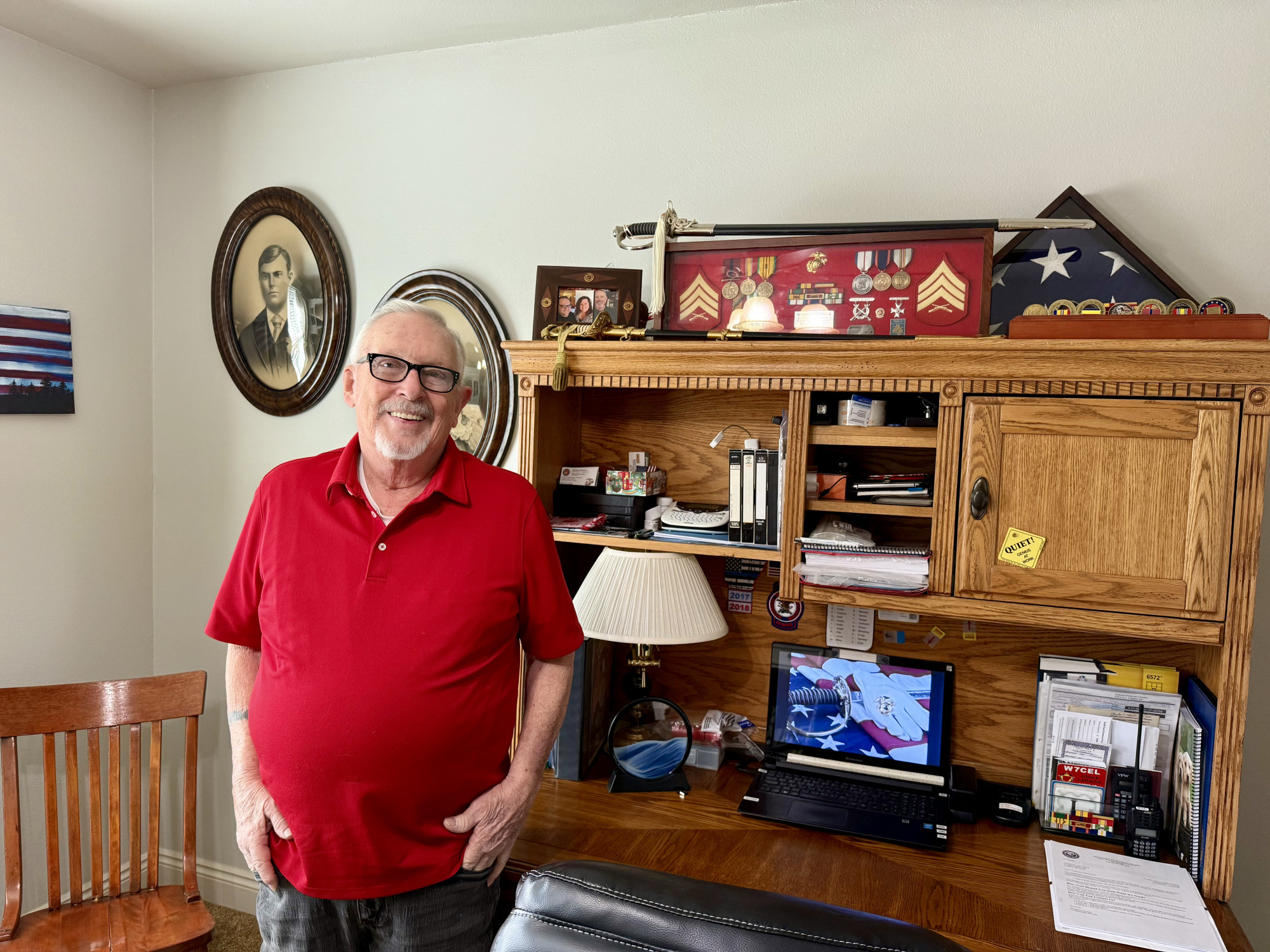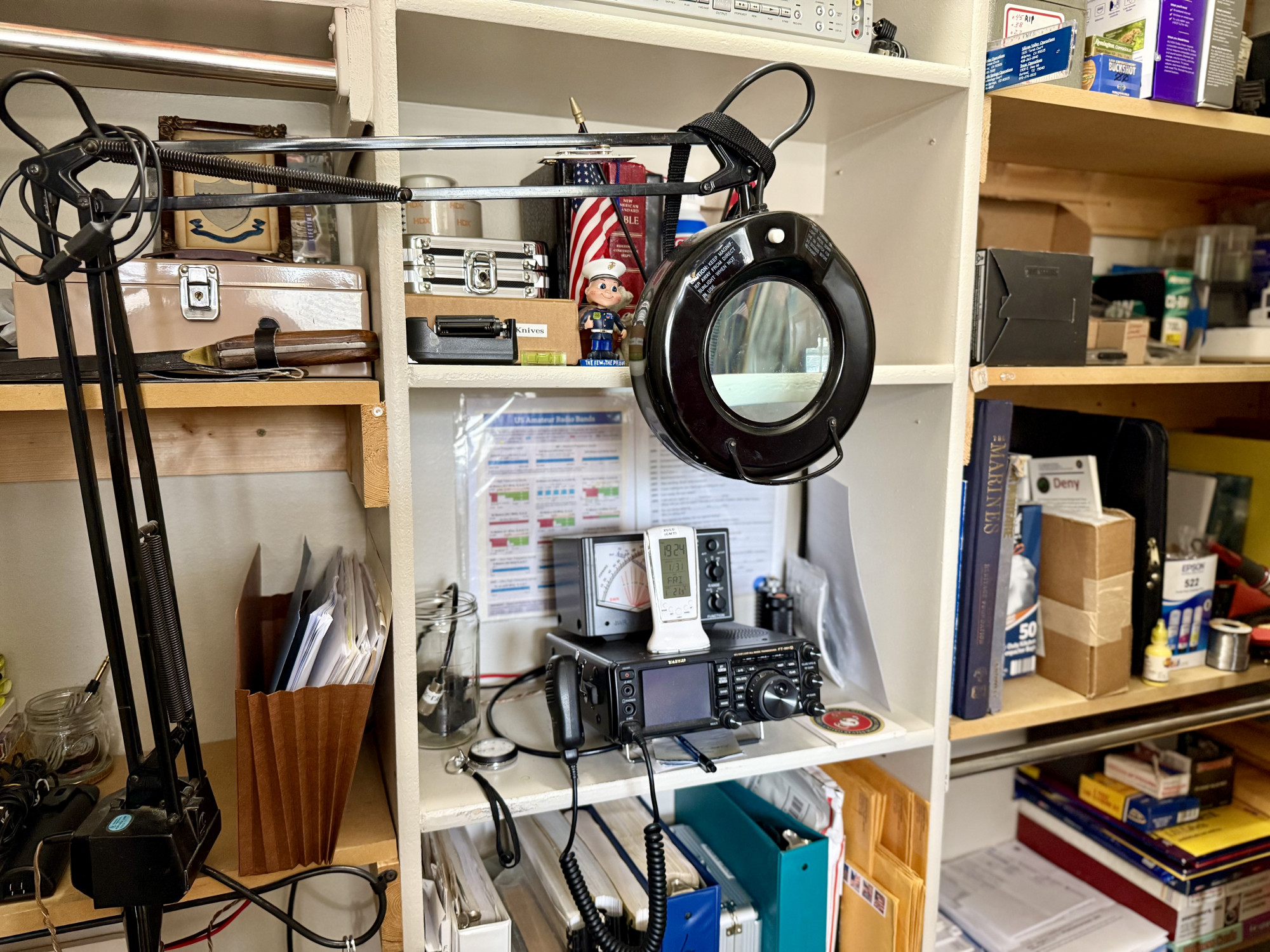The Gun Dealers Working to Prevent Suicide
Arkansas retailers provide safe and free storage through The Armory Project
By Caroline McCoy

Chuck Leftwich is one of three firearm dealers in Arkansas providing temporary storage for gun owners in crisis. Courtesy of Author
In August of 2024, licensed gun merchants around Arkansas began receiving calls from their local Veterans Affairs offices asking, “Would these retailers be willing to store firearms for gun owners in crisis?” The VA offices’ goal was to prevent deaths by suicide, which impact veterans at roughly a fifty-seven percent higher rate than civilians, according to national data collected by the VA. One of these calls reached Chuck Leftwich, a Vietnam veteran and licensed federal firearms dealer, or FFL, who operates out of his home in Cabot. “I have a definite interest in preventing suicides,” Leftwich said. “I have the capability to store firearms. . . . I was more than willing to join the program.”
The program is The Armory Project, or TAP, a VA-funded initiative that began in 2019 in Louisiana. Partnering with federally licensed firearm dealers to provide a safe and free storage option, TAP brings conversations about suicide prevention to spaces where veteran and non-veteran gun owners often find community. According to Claire Houtsma, a suicide prevention coordinator for the Southeast Louisiana Veterans Health Care System and the co-principal investigator for TAP, the program also formalizes a service some firearm retailers have long been providing. “We held a lot of focus groups with folks from the firearm industry,” Houtsma said. “And what we learned from that was that the idea of temporarily storing a firearm out of the home during a time of mental health crisis was something that was not only . . . acceptable, for the most part, to firearm owners, but it’s something that many retailers were already kind of doing on their own.”
Between 2019 and much of 2023, The Armory Project endured lapses in funding, but the initiative continued to flourish, with more retailers volunteering to serve as firearm storage partners. As the program expanded to include twenty-two retailers around Louisiana, Houtsma and her colleagues began receiving inquiries about launching the program in other states. “We didn’t really have the capacity to help everybody do something like this,” Houtsma said. To start growing the program sustainably beyond Louisiana, TAP looked to neighboring Arkansas, where the rates of gun ownership were similar. In both states, more than half the population owns firearms, a fact that correlates with rural landscapes and strong hunting cultures—forty-one percent of Arkansans and twenty-nine percent of Louisianans live in rural areas. Suicide-prevention specialists working in the Arkansas VA system agreed to lead a four-month pilot program in the state. In addition to Chuck Leftwich, two other FFLs signed on to participate: John Lykins of Lowell, in Northwest Arkansas, and Paul Silver who, like Leftwich, operates in Cabot. Both Lykins and Silver sell firearms out of brick-and-mortar stores—Silver at Unlimited Firearms & Outfitters and Lykins at Live+Well Pharmacy, where he maintains a retail inventory of roughly three hundred firearms and also works as a pharmacist.
All three participating FFLs received training in suicide prevention, as well as marketing materials to display or distribute within their communities. Angie Waliski, a counselor and researcher with the Central Arkansas Veterans Healthcare System, meets monthly with Leftwich, Lykins, and Silver and has been tracking the program’s reach. Between August and November of 2024, when the program was in its pilot phase, Waliski was able to account for 386 conversations initiated by the three storage partners and a total of nine guns that were voluntarily released by their owners for temporary storage.
According to Lykins, two of those nine guns were brought to Live+Well Pharmacy for temporary storage by a veteran whose wife had seen the Armory Project brochures by the store’s register. “They had been to the VA that day,” Lykins said. “He had had prostate cancer before, . . . and it had come back.” The woman told Lykins the devastating news and asked him to explain the brochures to her. “They checked his guns in the next day,” he said. Lykins has also stored firearms for a couple going through a divorce—“They just felt like it was safer to check them in”—and a veteran who supplied little explanation. “That was fine,” said Lykins. “I don’t want to pry too much.”

Leftwich, an amateur radio operator, spreads the word about The Armory Project during his broadcasts. Courtesy of Author
The Armory Project does not collect information about any gun owner who chooses to store firearms with one of their retail partners. “That’s really a relationship between the firearm retailer . . . and the customer,” Houtsma said. This allows participating gun dealers to maintain trust with their clients, many of whom express wariness over the prospect of temporarily storing their firearms and shame about the psychological distress that might be leading them to consider the option. “I give them the information that there is a safe place,” said Chuck Leftwich. “Nobody’s going to attack their Second Amendment. Nobody’s going to put them on any kind of list. Nobody but the owner and the firearms dealer are involved with this.”
Without a physical retail location, Leftwich has engaged in a grassroots effort to disseminate information about the program, sharing materials with law enforcement and first responders, clergy, mental health providers, and group leaders at his local American Legion, where he serves on the Honor Guard. These materials relay the facts—in the United States, an average of seventy-four people take their lives using a firearm every day; in Arkansas, sixty-two percent of suicides are by firearm; putting time and distance between a person in crisis and their firearms helps keep them safe from suicide—but they also employ language and iconography that veterans will recognize. One prominent image, used on both a brochure and a flyer, shows a man’s arm extended, his fist clutching the barrel of a rifle. Tattooed across the inside of his forearm is “;IGY6,” a military abbreviation for “I’ve got your six” or “I’ve got your back.”
Leftwich shares these materials with both veterans and civilians, knowing that the brochures and flyers will resonate with the former group and hoping that they’ll inspire the latter group to ask questions. “The position I’ve taken is to try and get attention to the program as widespread as I can,” he said. Since joining TAP as a storage partner last August, he has distributed more than seventy-five information packets to churches and community organizations within the tri-city area of Cabot, Ward, and Austin. During his hometown’s annual festival, last October, he set up a booth so that he could talk to people directly about the TAP. As an amateur radio operator, he shares messages about the program during on-air meetings—or nets—with radio operators in other regions. “Any and everybody who is under stress or in distress, this program applies to them,” he said.
Leftwich recognizes himself as a valuable messenger for The Armory Project. He is not just a federal firearms dealer but a gun collector, not just a veteran but an active participant in VA programs. He is recognizable within his community, known for riding his Honda Gold Wing motorcycle and his devotion to wearing red on Fridays—a color that is also an acronym: Remember Everyone Deployed. Leftwich will turn eighty in May. He has spent the majority of those years immersed in military culture—first as a young marine in Vietnam and later as an aerospace engineer for defense contractors. When he was a boy growing up in Dallas, his mother taught him to shoot, and he has been enthusiastic about guns and shooting sports ever since. But he has also seen firsthand the devastation they can cause. At nineteen, when he was stationed at Camp Pendleton in Southern California, he was called to respond to the suicide of a young soldier by firearm. “This was my first encounter with it,” Leftwich said. “It was really a sad situation. I mean, nobody knew anything. It just . . . Boom, it happened.”

Leftwich has delivered more than seventy-five information packets to community organizations in his region. Courtesy of Author
Nine out of ten suicide attempts by firearm are fatal. The distance between the decision and the act is often short, sometimes amounting to seconds. Intervening within that window is either impossible or dangerous, so Leftwich, Lykins, and others working with The Armory Project devote their time to raising awareness about the benefits of temporary storage, particularly among those who may be experiencing a crisis. “If they’re not willing to separate themselves from their weapon, then we try to go for smaller steps,” said Laura Watlington, a TAP partner and manager of the Suicide Prevention Program at the Central Arkansas Veterans Healthcare System. She has advocated for separating ammunition from firearms and using gun locks and gun safes. “But out of home,” she said, “is ultimately the safest way to store the firearms.”
Between November 2023 and January 2025, The Armory Project stored a total of 229 firearms across both Louisiana and Arkansas; but that number is just one way the program accounts for its impact. “We may not end up storing huge, huge numbers of firearms,” said Claire Houtsma. “But with the kind of conversations that are being had in this space among firearm owners—that helps decrease the stigma about asking for that help.”




